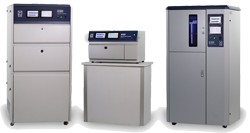耐候性試驗(yàn)
Weathering Testing
咨詢熱線
18566398802ASTM D4674-2002
ASTM D4674-2002標(biāo)準(zhǔn)介紹
ASTM D4674 暴露在室內(nèi)辦公室環(huán)境下的塑料顏色穩(wěn)定性加速試驗(yàn)的標(biāo)準(zhǔn)實(shí)施規(guī)范(暴露在室內(nèi)熒光燈和透窗入室日光下的塑料顏色穩(wěn)定性加速試驗(yàn)的標(biāo)準(zhǔn)試驗(yàn)方法)
ASTM D4674-2002發(fā)行信息
標(biāo)準(zhǔn)號(hào)ASTM D4674-2002a(2010)
中文名 暴露在室內(nèi)熒光燈和透窗入室日光下的塑料顏色穩(wěn)定性加速試驗(yàn)的標(biāo)準(zhǔn)試驗(yàn)方法
英文名 Standard Practice for Accelerated Testing for Color Stability of Plastics Exposed to Indoor Office Environments
發(fā)布日期2002
實(shí)施日期
廢止日期無
中國(guó)標(biāo)準(zhǔn)分類號(hào)G31
國(guó)際標(biāo)準(zhǔn)分類號(hào)83.080.01
發(fā)布單位US-ASTM
代替標(biāo)準(zhǔn)No Replacement
ASTM D4674-2002適用范圍
根據(jù)本實(shí)施規(guī)程進(jìn)行的試驗(yàn)旨在引起與典型辦公環(huán)境中的光照和熱暴露相關(guān)的性能變化。這些暴露不是為了模擬局部現(xiàn)象(如搬運(yùn)、污垢污染等)造成的劣化。
附注58212;警告:警告:有關(guān)適用于所有實(shí)驗(yàn)室風(fēng)化裝置的完整警告指南,請(qǐng)參考規(guī)程G151。關(guān)于可變性來源以及通過實(shí)驗(yàn)室加速暴露試驗(yàn)的設(shè)計(jì)和數(shù)據(jù)分析解決可變性的策略的更多信息,請(qǐng)參見指南G141。
本實(shí)施規(guī)程中描述的不同方法之間可能存在結(jié)果差異。例如,所用燈具光譜分布的差異和單個(gè)燈具輻照度的變化可能導(dǎo)致試驗(yàn)結(jié)果的顯著差異。因此,除非附有根據(jù)第12節(jié)編制的報(bào)告,說明需要包括對(duì)所用方法的引用,否則不得提及本慣例的使用。
當(dāng)根據(jù)與其他材料或?qū)φ瘴锵啾鹊男阅艿燃?jí)評(píng)估材料的穩(wěn)定性時(shí),實(shí)驗(yàn)室間試驗(yàn)結(jié)果的再現(xiàn)性已被證明是良好的。因此,強(qiáng)烈建議在試驗(yàn)材料的同時(shí)暴露具有已知性能的類似材料(對(duì)照)。建議對(duì)每種材料至少進(jìn)行三次重復(fù),以便對(duì)結(jié)果進(jìn)行統(tǒng)計(jì)評(píng)估。
Tests conducted in accordance with this practice are intended to induce property changes associated with use exposure to light and heat in typical office environments. These exposures are not intended to simulate the deterioration caused by localized phenomena such as handling, dirt contamination, etc.
Note 58212;Caution: Caution: Refer to practice G151 for full cautionary guidance applicable to all laboratory weathering devices. Additional information on sources of variability and on strategies for addressing variability by design and data analysis of laboratory accelerated exposure tests is found in Guide G141.
Variation in results may be expected are possible between the different methods described in this practice. For example, differences in spectral distribution of the lamps used and variations in the irradiance for a single type of lamp can cause significant differences in test results. Therefore, any no reference to the use of this practice should be made unless accompanied by a report prepared in accordance with Section 12 that describes needs to include a reference to the method used.
Reproducibility of test results between laboratories has been shown to be good when the stability of materials is evaluated in terms of performance ranking compared to other materials or to a control. Therefore, exposure of a similar material of known performance (a control) at the same time as the test materials is strongly recommended. It is recommended that at least three replicates of each material be exposed to allow for statistical evaluation of results.
1.1 This practice covers the basic principles and operating procedures for using fluorescent light to determine color stability of plastics when materials are exposed in typical office environments where fluorescent overhead lighting and window-filtered daylight are used for illumination and where temperature and humidity conditions are in accordance with American Society of Heating, Refrigerating, and Air-conditioning Engineers (ASHRAE) recommendations for workers'' comfort.
1.2 This practice describes four methods where specimens are exposed to fluorescent light under controlled environmental conditions. Two of the methods use an exposure device that provides for mixing of fluorescent lamps and two of the methods use devices that comply with Practice G154.
Note 18212;Method I uses cool white fluorescent lamps and window glass filtered fluorescent UVB lamps and is the same method described in previous versions of this standard.
1.3 Specimen preparation and evaluation of the results are covered in ASTM methods or specifications for specific materials. General guidance is given in Practice G151. More specific information about methods for determining the change in properties after exposure and reporting these results is described in Practice D5870.
1.4 The values stated in SI units are to be regarded as the standard.
1.5 Unless otherwise specified, all dimensions are nominal.
1.6 This practice may involve hazardous materials, operations, and equipment. This standard does not purport to address all of the safety concerns, is any, associated with its use. It is the responsibility of the user of this standard to establish appropriate safety and health practi......
溫馨提醒:本ASTM D4674-2002可能存在更新的版本,建議尋找ASTM D4674-2002的發(fā)行商確認(rèn)。
- 中國(guó)汽車工程學(xué)會(huì)《汽車零部件及材料實(shí)驗(yàn)室循環(huán)腐...
- Q-SUN氙燈試驗(yàn)箱得到了Ford汽車BO 1...
- 循環(huán)鹽霧腐蝕測(cè)試技術(shù)網(wǎng)絡(luò)研討會(huì)圓滿結(jié)束...
- 美國(guó)Q-lab推出全新的萬能校準(zhǔn)儀...
- 循環(huán)鹽霧腐蝕測(cè)試技術(shù)網(wǎng)絡(luò)研討會(huì)問題收集與解答...
- 循環(huán)鹽霧腐蝕測(cè)試技術(shù)網(wǎng)絡(luò)研討會(huì)視頻回放...
- Q-fog鹽霧試驗(yàn)箱錯(cuò)誤代碼解析...
- Q-fog鹽霧試驗(yàn)箱有哪些安全傳感器...

 粵公網(wǎng)安備 44060402000067號(hào)
粵公網(wǎng)安備 44060402000067號(hào)